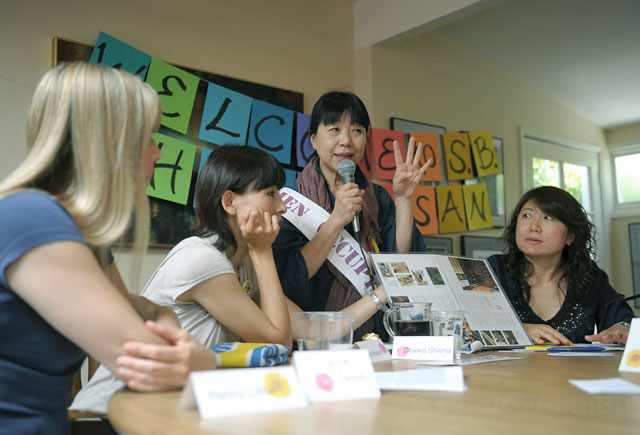From Fukushima to Diablo Canyon
Fallout from Nuclear Meltdown Persists

There are about 5,200 miles separating Fukushima, Japan — site of last year’s massive meltdown at the Daiichi nuclear power plant — and Avila Beach, California, home of the Diablo Canyon nuclear power plant, but for Chieko Shiina, a prematurely retired organic farmer from Fukushima turned anti-nuke activist, the message remains the same. “Please learn from our experience,” she told a small gathering clustered in an airless room Tuesday afternoon. “Stop the nuclear power plants right now.”
Shiina, who spoke through as many as four interpreters, is attempting to raise money to open an independent medical clinic, she explained, so the doctors won’t insist so adamantly there’s no connection between the symptoms they witness and the massive quantities of radiation released last year. In fact, she said, they won’t even talk about it. “To talk about radioactive stuff,” she said, “is taboo.” Nurses, she said, will shush patients who suggest there might be a connection. And a high-ranking government medical official, she said, was dispatched to Fukushima in the wake of the disaster to affirmatively dispel concerns about radiation exposure. “The doctor tells them there’s no relationship with radiation at all,” Shiina said. “He said, ‘If you keep laughing, you’re not going to get sick.’”
The clinic Shiina has in mind is modeled on community clinics that popped up in Hiroshima after the United States dropped an atom bomb on that city in 1945. “People don’t have a place to go to take their worries,” she said, “not a place where the doctor hides all the information.” To date, she said, she’s raised $200,000 and has commitments from seven doctors to staff it. Her goal is $3 million.
While it remains too soon to determine the health impacts of the Fukushima disaster, Shiina said it’s common to see people with persistent coughs, bloody noses, dark circles under their eyes, chronic headaches, and lumps on their thyroid glands. Because the soil remains contaminated, Shiina said she was forced to move, giving up her farming operation as well as the inn she ran. But she has daughters and grandchildren who could not leave. There have been 30,000 children evacuated, she reported, but another 300,000 still remain. Although children are more susceptible to radiation’s effects, she said, government health officials responded early to the crisis by increasing acceptable exposure levels by 20 times.
“The nuclear power plant is like an apartment without toilets,” she said. “Radioactive waste — no place to go with it.” It was that accumulated waste — stored in vast industrial cooling ponds — that caught fire three days after the massive earthquake and accompanying tsunami hit the Daiichi plant with a lethal one-two punch. It was that fire that made Fukushima the worst nuclear disaster since the Chernobyl meltdown of 1986. A recent report commissioned by the Japanese Parliament concluded that “ignorance and arrogance” caused the disaster, not violent acts of nature.
The report found that government oversight of the nuclear power industry was toothless and cozy. It also concluded that the earthquake itself — and not the tsunami it unleashed — may have damaged the plant’s protective infrastructure, the first of four major investigations to make that finding. If borne out, this conclusion would likely raise the design-safety threshold required of all Japanese nuclear power plants — which typically supply one-third of that nation’s energy needs — requiring retrofits estimated in the billions of dollars.
Since last year’s March 11 catastrophe all nuclear power plants have been shut down to ensure their safety. But with the summer’s hot season fast approaching, one of Japan’s nuclear power plants was just refired and is now operating at full throttle. In anticipation, Shiina said, antinuclear protesters began assembling outside the house of Japan’s prime minister. First, she said, there were a few hundred, then a few thousand. But by June 29, she stated, there were 200,000 — the most anywhere since 1960 — and another 1,500 stationed in front of the nuclear power plant itself. (Such crowds notwithstanding, voters in one Japanese prefecture voted two-to-one to reelect an adamantly pro-nuke governor, indicating that the political debate over one of Japan’s energy mainstays is far from resolved.)
Shiina was on her way to San Luis Obispo to speak before a crowd of longtime critics of Diablo Canyon, a nuclear power plant dogged by recurring questions of seismic impregnability. Such issues are currently the focus of high-tech tests, but the plant is currently operating at full bore. The same cannot be said of California’s other nuclear power installation at San Onofre, shut down since last winter because of serious corrosion afflicting hundreds of its steam pipes



